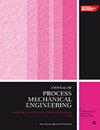Investigation to enhance the mechanical properties of damaged flat-clinching joints by reconditioning processes
IF 2.2
4区 工程技术
Q2 ENGINEERING, MECHANICAL
Proceedings of the Institution of Mechanical Engineers, Part E: Journal of Process Mechanical Engineering
Pub Date : 2024-07-25
DOI:10.1177/09544089241263152
引用次数: 0
Abstract
Joint damage could reduce component reliability and safety. In this paper, a simple and convenient reconditioning process for flat-clinching joints was proposed. The damaged joint was compressed by applying reconditioned force through the upper and lower flat dies to improve the mechanical properties. Compared to other exiting research, the process is easy to operate and requires no additional attachments. Meanwhile, the damage status of the loaded joint, material flow and the causes of improving mechanical properties were illustrated. In addition, the effect law of various reconditioned forces on the mechanical properties of the joints was also investigated. The results show that the flat-clinching joints are damaged when loaded beyond the shear load. However, the mechanical properties can be reconditioned when the interlocking structure remains unbroken. The main reason is that the reconditioning process reconstructs the interlocking structure and increases the neck thickness. Besides, the joint bulge height is also reduced by the reconditioning process. With increased reconditioning forces, the mechanical properties improve. The best mechanical properties are obtained at the recondition force of 40 kN. Compared to the original damaged joints, the shear force and energy absorption of the 40 kN reconditioned joints increased by 33.5% and 70.2%. This is important to promote the development of reconditioning processes and ensure part safety.通过修复工艺提高受损平压接头机械性能的研究
接头损坏会降低部件的可靠性和安全性。本文提出了一种简单方便的平咬合接头修复工艺。通过上下平模施加修复力,对损坏的接头进行压缩,从而改善其机械性能。与其他现有研究相比,该工艺操作简便,无需额外附件。同时,还说明了加载接头的损坏状态、材料流动以及改善机械性能的原因。此外,还研究了各种修复力对接头机械性能的影响规律。结果表明,当负载超过剪切负载时,平咬合接头会损坏。然而,当联锁结构未被破坏时,机械性能是可以恢复的。主要原因是修复过程重建了互锁结构,增加了颈部厚度。此外,连接凸起高度也会因修复过程而降低。随着翻新力的增加,机械性能也会提高。当修复力为 40 kN 时,机械性能最佳。与原始受损接头相比,40 kN 修复接头的剪切力和能量吸收率分别提高了 33.5% 和 70.2%。这对促进翻新工艺的发展和确保零件安全具有重要意义。
本文章由计算机程序翻译,如有差异,请以英文原文为准。
求助全文
约1分钟内获得全文
求助全文
来源期刊
CiteScore
3.80
自引率
16.70%
发文量
370
审稿时长
6 months
期刊介绍:
The Journal of Process Mechanical Engineering publishes high-quality, peer-reviewed papers covering a broad area of mechanical engineering activities associated with the design and operation of process equipment.

 求助内容:
求助内容: 应助结果提醒方式:
应助结果提醒方式:


